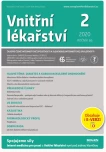-
Medical journals
- Career
Obesity and cardiovascular disease
Authors: Štěpán Svačina
Authors‘ workplace: III. interní klinika UK – 1. LF a VFN Praha
Published in: Vnitř Lék 2020; 66(2): 89-91
Category: Main Topic
Overview
Obesity with no comorbidities probably carries no cardiovascular risk, and the so-called obesity paradox even comes into play, wherein obesity may improve the prognosis of cardiovascular disease. Cardiovascular complications primarily occur indirectly due to metabolic comorbidities of obesity. However, a thrombogenic potential of obesity has also been established. A very important question in contemporary obesitology is whether antidiabetics currently administered in obese non-diabetic individuals will have a positive cardiovascular effect similar to that in diabetics. Myokines, muscle tissue hormones, certainly have a protective effect on the cardiovascular system. Also of importance is the research into epicardial and pericardial fat. Its investigation and management will aid in finding additional options of diagnosing and treating cardiovascular disease.
Keywords:
antidiabetics – obesity paradox – cardiovascular risk – obesity complications – antiobesity drugs – epicardial fat – pericardial fat
Sources
1. Isomaa B, et al. Cardiovascular morbidity and mortality associated with the metabolic syndrome. Diabetes Care. 2001 Apr; 24(4): 683–689.
2. Svačina Š. Obezitologie a teorie metabolického syndromu Triton Praha 2015.
3. Svačina Š. Obezita a srdce Vnitr Lek. 2014 60(12): 1068–1071.
4. Jee SH, et al. Body‑mass index and mortality in Korean men and women. N Engl J Med. 2006 Aug 24; 355(8): 779–787.
5. Stránská Z. Svačina Š. Myokiny hormony svalové tkáneVnitr Lek. 2015 61(4): 365–368
6. Svačina Š. Léčba obézního diabetika Mladá Fronta Praha 2018.
7. Svačina Š. Antidiabetika Historie současnost a budoucnost, Axonite, Praha 2016
8. Svačina Š. Jsou metabolická onemocnění příčinou všech nemocí. Mladá Fronta, Praha 2019.
9. Luo WS, et al. Interaction of tobacco smoking and alcohol consumption with obesity on cardiovascular disease in a Chinese cohort. Coron Artery, DiS. 2019 Dec 19 e - publikace.
10. Mewes C, et al. Favorable 90-Day Mortality in Obese Caucasian Patients with Septic Shock According to the Sepsis-3 Definition. J Clin Med. 2019 Dec 24;9(1). e‑publikace.
11. Svačina Š. Akutní infekce a riziko infarktu myokardu. Svět praktické medicíny 1, 2019, 9–10.
12. Saioth M, et al. Effect of obesity and underweight status on the hospital‑acquired functional decline in patients with cardiovascular surgery: an analysis of data from a prospective observational multicenter cohort study. Gen Thorac Cardiovasc Surg. 2019 Dec 21. e‑publikace.
13. Liu X, et al. The obesity paradox for outcomes in atrial fibrillation: Evidence from an exposure‑effect analysis of prospective studies. Obes Rev. 2019 Dec 17. e‑publikace.
14. Ueda Y, et al. Association Between the Presence or Severity of Coronary Artery Disease and Pericardial Fat, Paracardial Fat, Epicardial Fat, Visceral Fat, and Subcutaneous Fat as Assessed by Multi-Detector Row Computed Tomography. Int Heart J. 2018 Jul 31; 59(4): 695–704.
15. Cabrera‑Rego J, et al. Epicardial fat thickness correlates with coronary in‑stent restenosis in patients with acute myocardial infarction. Clin Investig Arterioscler. 2019 Mar - Apr; 31(2): 49–55.
16. Nabati M, et al. Epicardial adipose tissue and its association with cardiovascular risk factors and mitral annular calcium deposits. Ultrasound. 2019 Nov; 27(4): 217–224.
17. Parisi V, et al. Statin therapy modulates thickness and inflammatory profile of human epicardial adipose tissue. Int J Cardiol. 2019 Jan 1; 274 : 326–330.
18. Greenwell AA, Chahade JJ, Ussher JR. Cardiovascular biology of the GIP receptor. Peptides. 2019 Dec 5 : 170228 e‑publikace.
19. Zhao D, et al. Cardiac‑derived CTRP9 protects against myocardial ischemia/reperfusion injury via calreticulin‑dependent inhibition of apoptosis. Cell Death, DiS. 2018 Jun 20;9(7): 723.
Labels
Diabetology Endocrinology Internal medicine
Article was published inInternal Medicine

2020 Issue 2-
All articles in this issue
- Incretin-based treatment of diabetes and cardiovascular complications
- The position of SGLT2 inhibitors in current medicine
- Obesity and cardiovascular disease
- Diabetic foot
- Diosmin/hesperidin: a cooperating tandem, or is diosmin crucial and hesperidin an inactive ingredient only?
- Blood vessel ageing and vascular memory
- Clinical aspects of epicardial fat deposition
- Adipocytokines and thyreopathies
- Thymoma – diagnostics options
- Clostridium difficile Infection: an update on treatment and prevention
- Hypoxemia/hypoxia and new concepts of oxygen therapy in intensive care
- Celiac disease in adults
- Cushing’s syndrome and acromegaly based on picoadenoma of the pituitary gland
- Inherited C2-complement deficiency: variable clinical manifestation (case reports and review)
- Differential diagnosis of hypoglycemia
- What is new for internists in ESC guidelines on diabetes?
- Diabetes a kardiovaskulární onemocnění
- Epidemiologie infekcí vyvolaných Clostridium difficile (CDI) v České republice
- Extraintestinální projevy celiakie
- RECENZE KNIHY ÚVOD DO VNITŘNÍHO LÉKAŘSTVÍ – doc. MUDr. Jitka Mlíková Seidlerová, Ph.D., a kol.
- Pioglitazone
- Relation between testosterone levels and body composition, physical functioning and selected biochemical parameters in adult males
- Internal Medicine
- Journal archive
- Current issue
- Online only
- About the journal
Most read in this issue- Differential diagnosis of hypoglycemia
- Hypoxemia/hypoxia and new concepts of oxygen therapy in intensive care
- Thymoma – diagnostics options
- Diosmin/hesperidin: a cooperating tandem, or is diosmin crucial and hesperidin an inactive ingredient only?
Login#ADS_BOTTOM_SCRIPTS#Forgotten passwordEnter the email address that you registered with. We will send you instructions on how to set a new password.
- Career

